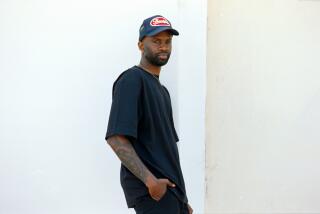They’re 100% kid
The kids in these photographs don’t look like they belong in a museum. They’re having too much fun. They gloat and grin, share secrets and show off their retainers and rock collections.
“I wanted to capture them exactly as they are,” says artist Kip Fulbeck. “ ‘If they liked soccer,’ I told them, ‘Bring a ball.’ ‘If you’re a goof be a goof.’ I just wanted to avoid that posed Christmas card thing.”
Most of all, Fulbeck wanted to give these children -- all of whom are of mixed racial heritage -- the freedom to answer the simple but potentially fraught question: “Who are you?”
Which is why the UC Santa Barbara art professor created “Mixed: Portraits of Multiracial Kids,” an exhibition that opens this weekend at the Japanese American National Museum downtown. The museum is an apt location for the show because it’s estimated nearly one-third of Japanese Americans are of mixed ancestry. The museum also hosted the premiere of Fulbeck’s first multiracial exhibit, “Part Asian, 100% Hapa,” in 2006.
For “Hapa” (a Hawaiian term used to refer to people who are part-Asian), Fulbeck photographed 1,200 volunteers and asked them to write responses to “What are you?” (“I used that wording because that’s what we get asked,” says Fulbeck, Chinese-Irish-English-Welsh.) He selected 80 images for the exhibition and 120 for a book published at the same time.
For “Mixed,” Fulbeck photographed about 500 children 12 and younger in California, Hawaii and New York. He selected nearly 80 images for the exhibition and roughly 125 for a companion book.
Fulbeck, 44, says the main inspiration for his latest project was the birth of his son, Jack, who just turned 1. Also, he says, he liked that “kids have a certain honesty that eludes adults” -- especially when it comes to race. Where the statements in “Hapa” might be political, poetic or self-categorizing, the children wrote or drew about what they liked to do or how they felt.
“That’s how they tell you who they are,” Fulbeck says. “One kid said, ‘I’m a little boy that has no friends.’ You’d be hard-pressed to find adults who’d say that.”
Parents were asked to describe their experiences raising multiracial children. Times have changed since he was growing up, Fulbeck notes. The census, for instance, now allows people to check off more than one box to describe their ethnic background. Even so, he still heard about students being taunted at school or mothers being asked, “Are you the nanny?”
“Everyone wants to tell their story,” says Fulbeck, who included lots of interactive opportunities in “Mixed.”
Activities planned for the exhibition, which runs through Sept. 26, include a visit June 12 by President Obama’s half sister, Maya Soetoro-Ng -- who like her brother is of mixed ancestry. Soetoro-Ng, who wrote the foreword to Fulbeck’s new book, will arrive June 12 to commemorate Loving Day, the annual celebration of the 1967 U.S. Supreme Court decision in Loving vs. Virginia that legalized interracial marriage in every state.
More to Read
The biggest entertainment stories
Get our big stories about Hollywood, film, television, music, arts, culture and more right in your inbox as soon as they publish.
You may occasionally receive promotional content from the Los Angeles Times.










